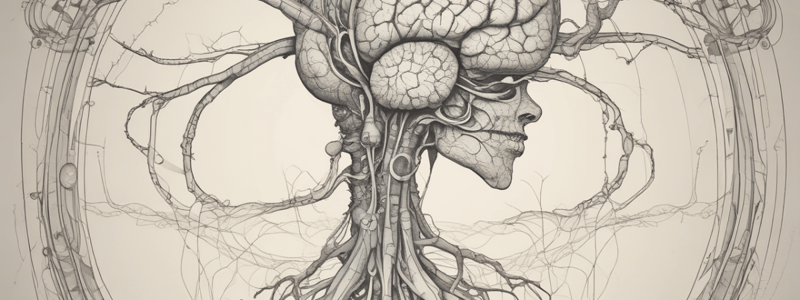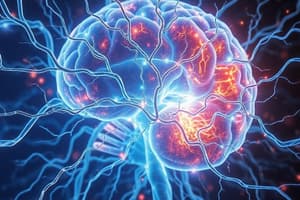Podcast
Questions and Answers
What was the significance of the Golgi stain in understanding the structure of neurons?
What was the significance of the Golgi stain in understanding the structure of neurons?
- It showed the existence of synapses between neurons
- It was widely adopted from the 1890s and revealed the complex architecture of neurons (correct)
- It proved that neurons are densely packed in the brain
- It demonstrated the classification of neurons into white and grey matter
What is the term for the colourful illustration of neuron structure shown in the picture?
What is the term for the colourful illustration of neuron structure shown in the picture?
- Purkinje's brain globule
- Brainbow (correct)
- Golgi's neuron illustration
- Neuron architecture diagram
What is the main function of the axon in a neuron?
What is the main function of the axon in a neuron?
- To receive signals from other neurons
- To regulate the release of neurotransmitters
- To carry information from dendrites to synapses (correct)
- To provide structural support to the neuron
What is the primary direction of information flow in a neuron?
What is the primary direction of information flow in a neuron?
What is the purpose of Na+/K+ pumps in neurons?
What is the purpose of Na+/K+ pumps in neurons?
What is the term for the region where the axon terminates and transmits information to other neurons?
What is the term for the region where the axon terminates and transmits information to other neurons?
What is the significance of understanding the development, axes, and subdivisions of the nervous system?
What is the significance of understanding the development, axes, and subdivisions of the nervous system?
What is the term for the local rebalancing of membrane potential in dendrites?
What is the term for the local rebalancing of membrane potential in dendrites?
What is the main distinction between white and grey matter in the nervous system?
What is the main distinction between white and grey matter in the nervous system?
What is the site of plasticity and learning in neurons?
What is the site of plasticity and learning in neurons?
What is the result of the unequal charge distribution across the neuron cell membrane?
What is the result of the unequal charge distribution across the neuron cell membrane?
What is the function of neurotransmitter receptors in neurons?
What is the function of neurotransmitter receptors in neurons?
What is the primary function of dendrites in neurons?
What is the primary function of dendrites in neurons?
What is the significance of the -70mV resting potential in neurons?
What is the significance of the -70mV resting potential in neurons?
What is the main function of projection neurons in the Layer V of the cortex?
What is the main function of projection neurons in the Layer V of the cortex?
Which type of neurons receive signals about touch, pain, and muscle stretch?
Which type of neurons receive signals about touch, pain, and muscle stretch?
What is the main function of myelination in the nervous system?
What is the main function of myelination in the nervous system?
Which part of the spinal cord contains motor neurons?
Which part of the spinal cord contains motor neurons?
What is the main function of voltage-gated sodium channels in axons?
What is the main function of voltage-gated sodium channels in axons?
What is the term for the process of action potential conduction in myelinated axons?
What is the term for the process of action potential conduction in myelinated axons?
Which type of neurons are responsible for controlling heart rate and respiration?
Which type of neurons are responsible for controlling heart rate and respiration?
What is the primary difference between electrical and chemical synapses?
What is the primary difference between electrical and chemical synapses?
What is the term for the gaps between myelinated segments of an axon?
What is the term for the gaps between myelinated segments of an axon?
What is the term for the modification of synaptic strength based on experience?
What is the term for the modification of synaptic strength based on experience?
What is the purpose of gap junctions in electrical synapses?
What is the purpose of gap junctions in electrical synapses?
What would be the effect of demyelination on action potential conduction?
What would be the effect of demyelination on action potential conduction?
Which type of neurotransmitter receptor determines whether a postsynaptic cell is excited or inhibited?
Which type of neurotransmitter receptor determines whether a postsynaptic cell is excited or inhibited?
What is the term for the small protrusions on dendrites that receive synaptic input?
What is the term for the small protrusions on dendrites that receive synaptic input?
What is the primary function of axoaxonic synapses?
What is the primary function of axoaxonic synapses?
What is the term for the process by which synaptic strength is modified based on the correlation between synaptic activity and postsynaptic action potentials?
What is the term for the process by which synaptic strength is modified based on the correlation between synaptic activity and postsynaptic action potentials?
What is the primary site of action for drugs targeting neurotransmitter receptors?
What is the primary site of action for drugs targeting neurotransmitter receptors?
What is the term for the phenomenon where the strength of a synaptic connection changes based on the proximity of the synapse to the axon initial segment?
What is the term for the phenomenon where the strength of a synaptic connection changes based on the proximity of the synapse to the axon initial segment?
During development, what is the term for the process by which the neural tube closes to form the brain and spinal cord?
During development, what is the term for the process by which the neural tube closes to form the brain and spinal cord?
What is the name of the type of glial cells that are neuronal progenitors?
What is the name of the type of glial cells that are neuronal progenitors?
What is the term for the type of birth defects that occur due to abnormalities in neurulation?
What is the term for the type of birth defects that occur due to abnormalities in neurulation?
What is the name of the type of neurons that migrate out of the neural tube during neurulation?
What is the name of the type of neurons that migrate out of the neural tube during neurulation?
What is the axis along which brain regions form during development?
What is the axis along which brain regions form during development?
What is the term for the type of glial cells that regulate brain homeostasis?
What is the term for the type of glial cells that regulate brain homeostasis?
What is the result of the unequal charge distribution across the neuron cell membrane during development?
What is the result of the unequal charge distribution across the neuron cell membrane during development?
What is the term for the type of neurons that arise from the neural crest and migrate out of the neural tube?
What is the term for the type of neurons that arise from the neural crest and migrate out of the neural tube?
Flashcards are hidden until you start studying
Study Notes
Cellular Structure of the Nervous System
- Neurons are densely packed and have a complex architecture that was invisible to early scientists.
- The Golgi stain was widely adopted from the 1890s and helped reveal the structure of neurons.
- Neurons are morphologically and functionally polarized, with a difference in the flow of electricity between dendrites and axons.
Structure of Neurons
- The flow of information is carried from dendrites to axons through to synapses.
- Neurotransmitters are released at synapses and bind to receptors on the postsynaptic neuron.
- Synapses are a site of plasticity and learning.
- Information is carried by graded potentials in dendrites, with a resting potential of -70 mV.
- The axon has a different membrane structure, with voltage-gated sodium channels activated at a threshold of -50 mV.
- Action potentials in axons are self-regenerating and "all-or-nothing".
Synapses
- Synapses are the junctions between neurons, and can be classified as electrical or chemical.
- Electrical synapses couple cells through gap junctions, allowing current to flow directly between neurons.
- Chemical synapses use neurotransmitters, which are released from the presynaptic neuron and bind to receptors on the postsynaptic neuron.
- Neurotransmitter receptors are targets for drug design, and agonists and antagonists of their receptors form the basis of many drugs.
Types of Neurons
- Cortical layers comprise different types of neurons, including projection neurons and local interneurons.
- Motor neurons are found in the ventral horn of the spinal cord and control muscles.
- Sensory neurons project into the dorsal horn of the spinal cord and receive signals from sensory receptors.
- Autonomic neurons are found in autonomic ganglia and control involuntary functions such as heart rate and respiration.
Myelination
- Myelination enhances communication over long distances by providing insulation and allowing for rapid passive conduction.
- Nodes of Ranvier are gaps in the myelin sheath where action potentials are regenerated.
- Saltatory conduction is 150 times faster than normal conduction.
Grey and White Matter
- Grey matter contains cell bodies, dendrites, and axons, while white matter contains myelinated axons.
- White matter is grouped into tracts or fascicles.
Development of the Nervous System
- During neurulation, the neural tube forms and eventually gives rise to the brain and spinal cord.
- The neural crest exits the dorsal tube and populates the peripheral nervous system.
- Brain regions form along a rostrocaudal axis that flexes during development.
- Neurulation defects can range from spinabifida to a complete loss of head (anencephaly).
Glial Cells
- Different types of glial cells have distinct morphologies relating to their different functions.
- Astrocytes regulate brain homeostasis.
- Radial glia are neuronal progenitors.
- Place of origin in the CNS determines neuron type.
- PNS arises from neural crest.
Studying That Suits You
Use AI to generate personalized quizzes and flashcards to suit your learning preferences.



